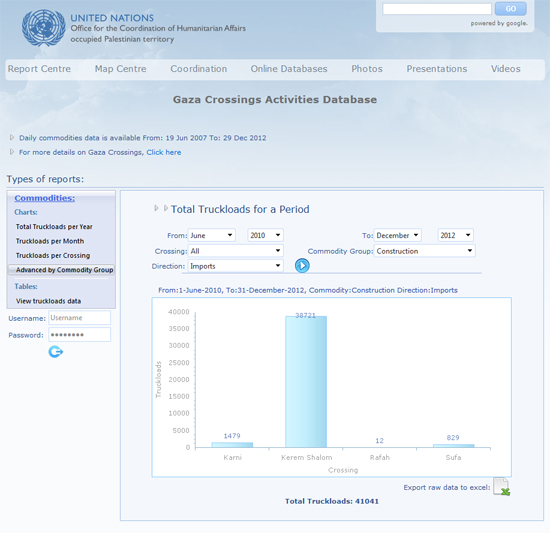
And yet, here’s yesterday’s headline from the print edition of the International Herald Tribune, which we first noted earlier today on our Snapshots blog:

As the accompanying article by Isabel Kershner correctly noted,
For the first time in five years, Israel on Sunday allowed truckloads of building materials into Gaza for use by the private sector, according to Israeli and Palestinian officials. . . .
Israel has strictly controlled the entry of building materials, limiting them in recent years to internationally supervised projects.
(A similar but longer version of the article which appeared in yesterday’s IHT print edition is available at the New York Times Web site.)
In addition to the New York Times, Nidal al-Mughrabi of Reuters also did a competent job explaining that the ban, lifted earlier this week, had applied only to the private sector, and that since 2010 Israel has permitted the passage of building materials for internationally supervised projects. Reuters reported:
Israel eased its blockade of Gaza on Sunday, allowing a shipment of gravel for private construction into the Palestinian territory for the first time since Hamas seized control in 2007.
A Palestinian official with knowledge of an Egyptian-brokered ceasefire that ended eight days of fighting last month between Israel and Gaza militants said the move had been expected as part of the deal.
“This is the first time gravel has been allowed into Gaza for the Palestinian private sector since the blockade,” said Raed Fattouh, the Palestinian official overseeing the shipment of 20 truckloads of the material.
Israel tightened the blockade after Hamas, an Islamist group that refuses to recognize the Jewish state, took power five years ago. But under international pressure, Israel began to ease the restrictions in 2010 and has allowed international aid agencies to import construction material.
The problematic Associated Press story, by Aron Heller and Ibrahim Barzak, was picked up by many other media outlets far and wide. The AP story opens:
In a major concession to Gaza’s Hamas leaders Monday, Israel dropped its five-year ban on construction materials crossing into the territory and raised hopes there that rebuilding could begin following a damaging eight-day Israeli air campaign.
Only in fourth paragraph do Heller and Barak allude to the fact that, contrary to the article’s first sentence, the ban did not apply to all building material. They write:
Although Israel eased the restrictions in 2010, building materials such as cement, gravel and metal rods were still largely banned because Israel claimed militants could use them to make fortifications and weapons.
Even those reading between the lines would not be able to glean from the fourth paragraph, that in fact, tens of thousands of trucks loaded with construction materials have made their way from Israel to the Gaza Strip, and that Israel permitted materials for construction projects overseen by aid groups such as UNRWA and the Red Cross.
Moreover, following the pyramid method, the Los Angeles Times used only the first two paragraphs, and took out the information lower down that cement, gravel and metal rods were “still largely banned” (as opposed to completely banned, as understood in the first paragraph of the story.) It’s not the Times’ fault; editors trust that the information provided in the lede of the AP story is factually correct.
Other media outlets that relied on the inaccurate AP story include Time, the Richmond Times-Dispatch, the Houston Chronicle, the Worcester Telegram and Gazette, and countless more. All of them, but AP first and foremost, must publish corrections making clear that in fact tens of thousands of trucks filled with construction materials have reached the Gaza Strip in the last two and a half years, and that the ban applied only to the private sector. Stay tuned for updates.
Read a related post by CAMERA-affiliate CiF Watch, “Guardian falsely claims that ‘almost no’ construction materials have entered Gaza“
